Huawei MateView GT review
Our Verdict
The Huawei MateView GT is the Chinese company's get-go gaming monitor, and a success in much (but not all) of what it attempts.
For
- Lots of features
- Potent color, brightness performance
- Integrated soundbar sounds proficient
Against
- Underwhelming aesthetic
- Beneath-average HDR brightness
- Curious soundbar design
- Limited global availability
Tom's Guide Verdict
The Huawei MateView GT is the Chinese company's first gaming monitor, and a success in much (simply non all) of what information technology attempts.
Pros
- +
Lots of features
- +
Stiff colour, effulgence operation
- +
Integrated soundbar sounds proficient
Cons
- -
Underwhelming aesthetic
- -
Below-average HDR brightness
- -
Curious soundbar blueprint
- -
Limited global availability
Huawei MateView GT: Specs
Screen Size: 34 inches
Resolution: 3,440x1,440
Refresh Rate: 165 Hz
Inputs: DisplayPort, HDMI, USB Type-C, three.5 mm audio
Dimensions: 31.8 x 21.3 ten 8.vii inches
The Huawei MateView GT marks the Chinese tech behemothic's outset foray into the gaming monitor infinite — and it's a apparent one. As you'd look from a company that provides products and services as diverse as smartphones and tablets, PCs and routers, wearables and audio, 5G and enterprise networking, and oh so much more, information technology'southward thrown everything information technology could into this smorgasbord of a project. Then from its curved, ultrawide configuration to its 165 Hz refresh rate, from its claimed high level of colour support to HDR10 potential, and from its above-average brightness to its integrated sound system, there'south a lot going on hither to appeal to the Everygamer who wants a one-stop-shop display.
The flip side of this is that even if you like a lot of what information technology does, its shortage of aggressive aesthetics and flawless follow-through for everything it attempts may forestall information technology from beingness ideal for your gaming setup. Merely if y'all need what it has — and if you're somewhere where yous're able to get your hands on information technology — it's worth a expect.
Huawei MateView GT review: Pricing and availability
As of this writing, the MateView GT is non currently available for purchase everywhere — including the United states. Per our contact at Huawei, at this phase in the monitor's global rollout, it is being sold in Europe, Africa, the Middle East, Asia, and Latin America. Exactly how much it costs depends on your location, simply pricing is presently pegged at £499.99 in the U.K. and €549.99 in France. That would be in keeping with a $650–$700 cost in terms of U.S. dollars. (Nosotros accept no information about additional planned availability in North America or elsewhere.)
Huawei MateView GT review: Design
For a gaming monitor, the MateView GT is efficiently designed. The front of its screen, which measures about 14.3 past 31.iv inches, is lined with sparse (less than i-8th inch) bezels on the left, correct, and tiptop, and a thicker (just over one-half inch) one on the bottom, which is only adorned with the Huawei logo.
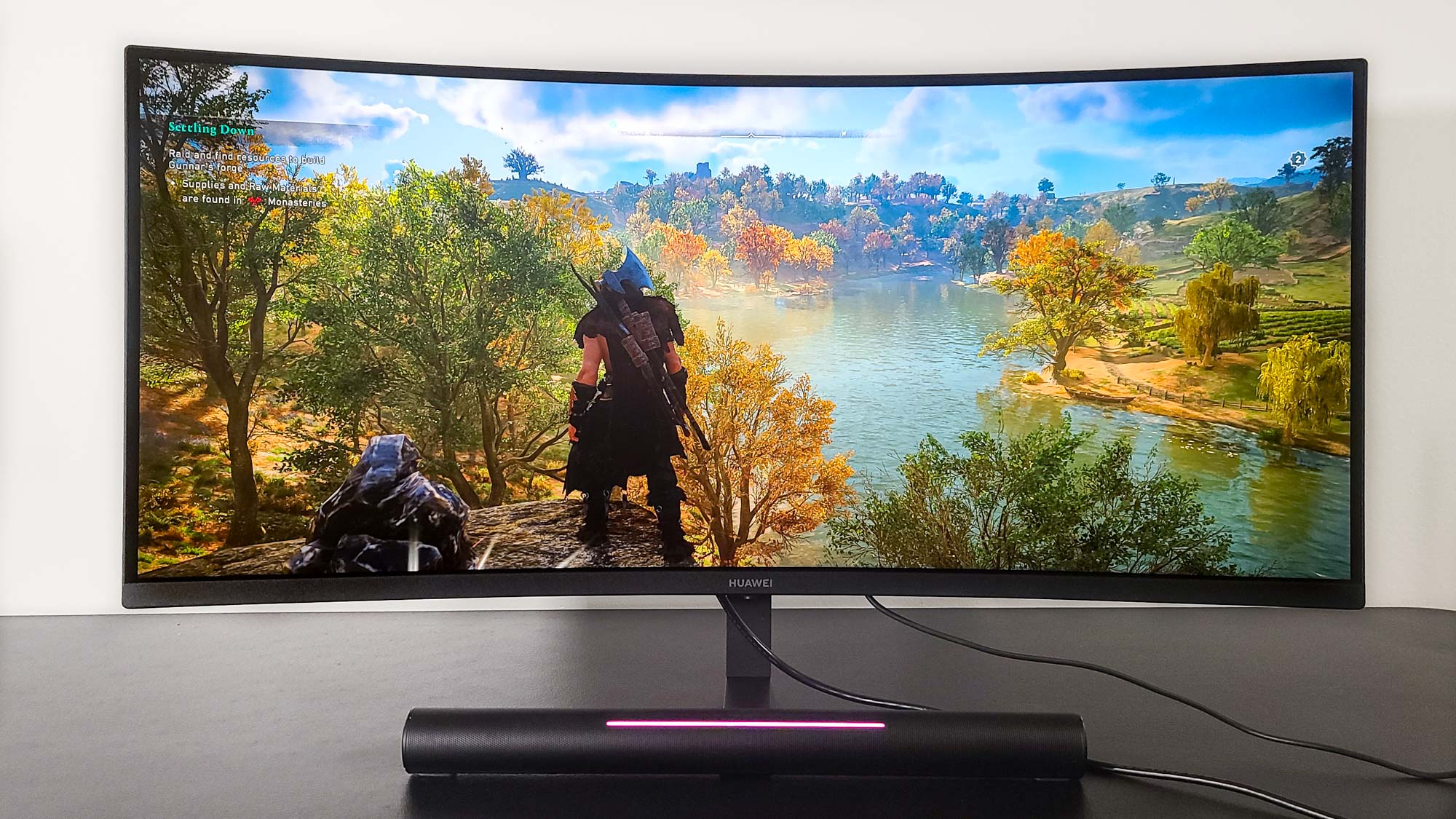
The rear of the monitor is fifty-fifty less flashy, with none of the intricately molded sci-fi patterns or throbbing LED slashes you see on something like the Gigabyte Aorus FI32U.
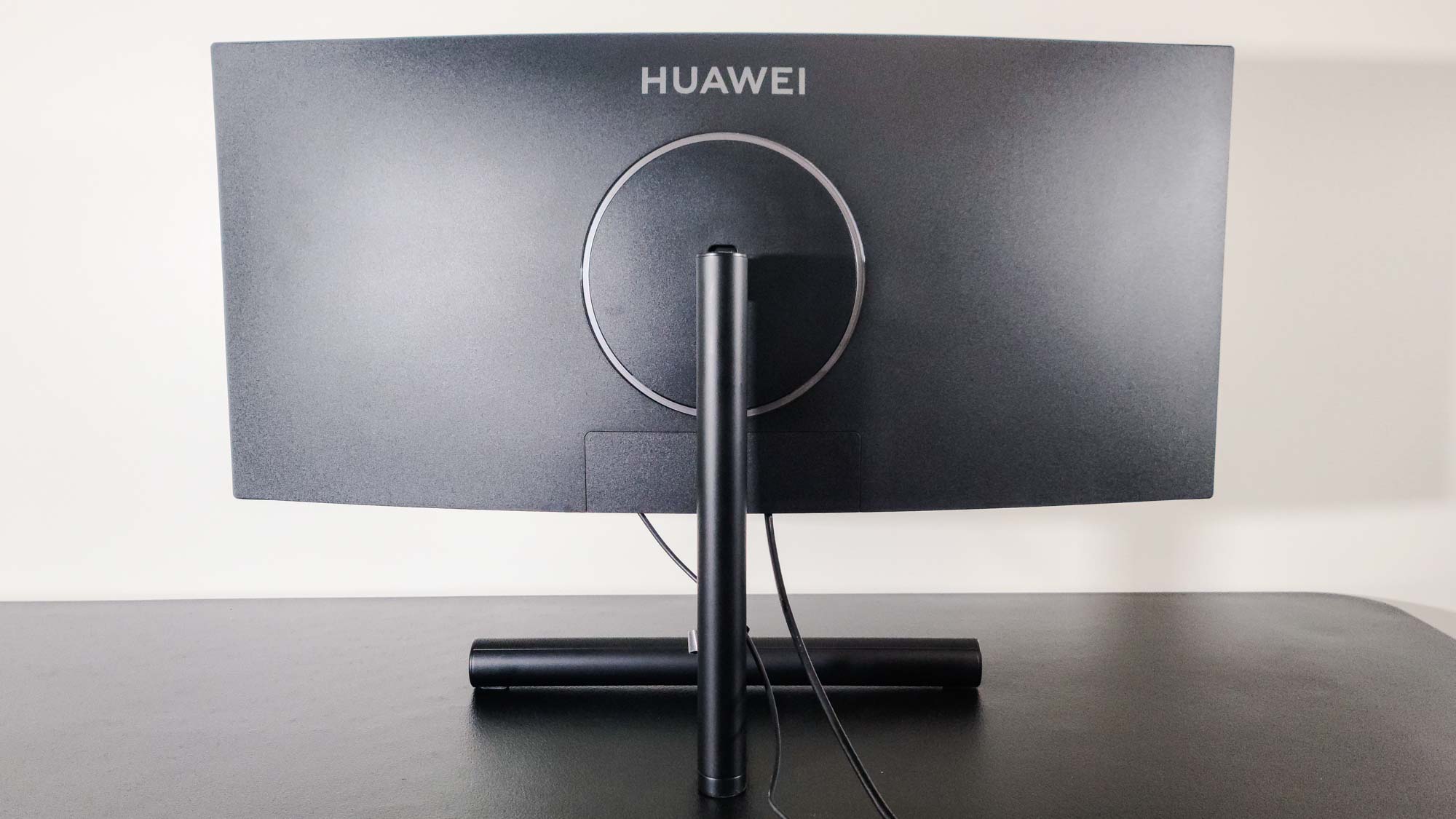
There's some other, larger Huawei logo at the peak, above the stand connector, a removable console below for hiding the ports (one USB Type-C for connecting the power adapter and another supporting data, DisplayPort one.4, and USB Power Delivery; two HDMI two.0 ports; one full-size DisplayPort one.iv connector; and a 3.5mm audio jack), a five-way joystick for navigating the on-screen brandish (OSD) on the screen's bottom edge, and little else.
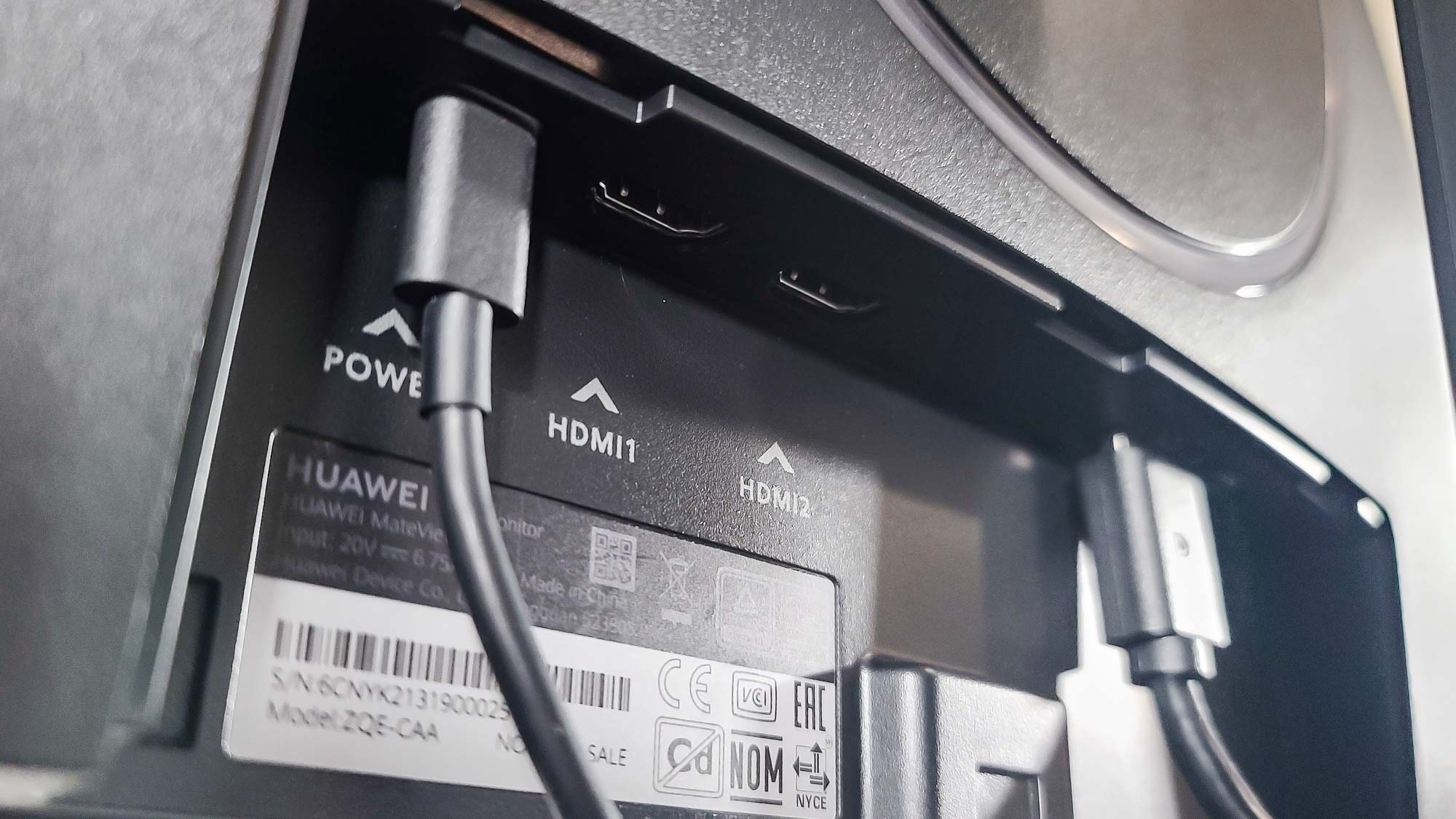
At least, that is, until you get downward to the bottom of the stand and discover that what appears to be its foot is, in fact, an integrated soundbar. The tubelike unit measures just nether 17.5 inches in length and almost 1.8 inches in width, and it contains dual five-watt speakers and sports a 7-inch RGB strip splashed down its center (nigh which more before long). An integrated dual-microphone array, with built-in noise cancellation, on the elevation of the screen completes the movie of the MateView GT equally fully equipped audio station.
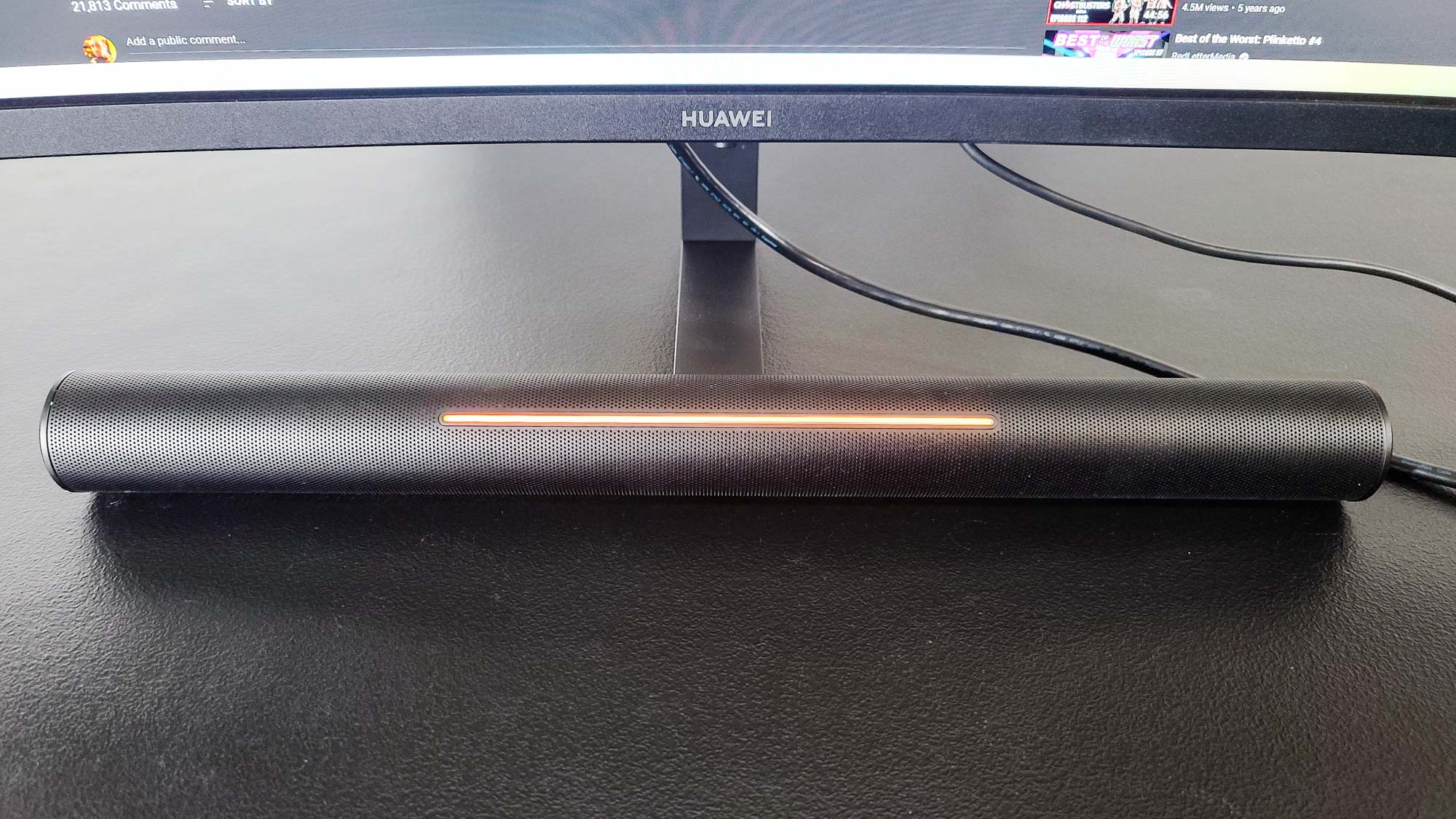
Equally for the stand itself, similar the screen, it'due south a non-nonsense matter, all black metal and plastic, supporting the screen and housing the soundbar while imparting no wow of its own. And although it does let you movement the monitor quite a ways upwardly and down, and tilt it frontwards and back, you can neither swivel the monitor left or correct (not helpful given how determinantal curved displays are to viewing angles to begin with) nor rotate it into portrait mode.
Huawei MateView GT review: Screen
The MateView GT'southward screen measures 34 inches on the diagonal and boasts a native resolution of 3,440x1,440. This isn't the narrowest or near ungainly we've seen—the Samsung Odyssey G9 and others of its v,120x1,440 ilk take that prize—merely it doesn't sync up with other standard resolutions (it's non double 1,920x1,080, for example, or double ii,560x1,440 like the Samsung), and then y'all will take to really desire the Ultra-Wide Quad HD (UWQHD) resolution for this to make sense for you. Its curvature of 1,500R, which ways it would extend out to a circle 1.5 meters (four.9 anxiety) in length, is across that of the 1,000R used by the Samsung to mimic the shape of the human being center and thus is slightly less realistically immersive.

The same, still, is not true of the monitor'southward color performance, which impresses in every picture manner. On its default settings (P3 fashion), it registered a 0.32 Delta-East (the value representing how accurately the monitor displays colors compared with the source, with lower numbers being better), covered 135.ii% of the sRGB colour gamut, and covered an even more heart-popping 95.8% of the wider DCI-P3 colour gamut. (All these measurements were taken using a calibrated Klein K10-A colorimeter and DisplayCal calibration software.) These numbers were occasionally bettered by other modes (Scenery had the best Delta-E, at 0.22, and FPS style covered the most of both gamuts, with results of 139.1% for sRGB and 98.6% for DCI-P3), but were, with ane exception, consistent throughout.
That exception was the MOBA mode, which shuts off various colors to reduce center strain during intense, professionally oriented gaming sessions for players of, say, Dota 2 and League of Legends. Not only was the color gamut coverage peculiarly atrocious in this style — 28.3% of sRGB and 20% of DCI-P3, and no, those are not typos — but the picture also looked bad. (Black-and-white monitors have not been a serious affair for decades, and I don't feel any pressing need for a resurgence.) Huawei is hardly alone in having a mode that does this, merely know that it's useless nether almost every imaginable situation. (See the next section for more.)
The MateView GT can get attractively bright in SDR mode. Using our K10-A with Klein's own ChromaSurf software, we noted that its maximum brightness hovers around 350 nits in every mode (with the brightest being Scenery, at 359 nits). In HDR mode, it increases a touch to only over 400 nits, which is okay but not scintillating for a monitor in this class.
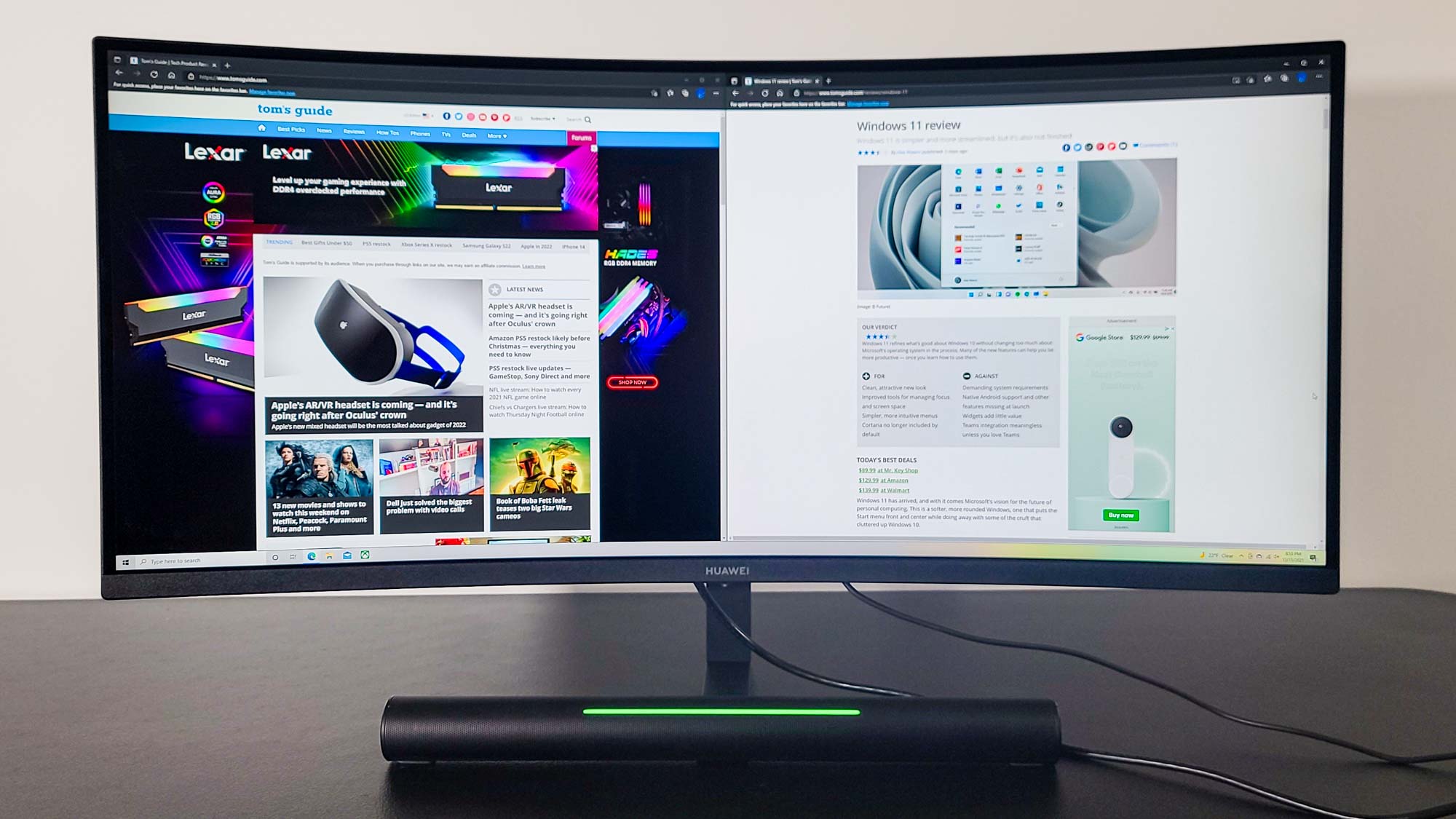
Our other top picks for ultrawide monitors, the 38-inch LG 38GL950G and the Samsung Odyssey G9, are roughly on par with the MateView GT in terms of sRGB color gamut coverage; the LG does a bit more (148.9%) and the Samsung a bit less (113.7%), though the Huawei beats the Samsung as far as DCI-P3 (with the G9 maxing out effectually fourscore.half-dozen%). Both those monitors do get brighter, though: The LG averages 544 nits of height effulgence and the Samsung 400 in SDR mode, with the latter getting up to 1,000 nits with HDR content (or 561 nits total screen).
These monitors are larger and pricier than the Huawei, granted, simply another, less expensive favorite, the 2,560x1,440 Razer Raptor 27, covers 162% of the sRGB gamut, and the 32-inch Corsair Xeneon 32QHD165 does even more than (194%), though neither monitor gets as vivid as the others.
Huawei MateView GT review: Performance
Allow's get one affair out of the style first: How well does that bonkers MOBA mode piece of work in practice? Danged if I know. Wait, I'm not an eSports athlete (or, er, any other kind of athlete), so have the following with a mine of salt. Simply I found that the drained-out, unrealistic, and anti-creative colors of Dota 2 pulled me out of that game rather than drawing me in, and the less said the better about how they looked in other Windows applications. If you want to minimize distractions then much that you're willing to sacrifice picture quality, maybe it's worth experimenting with, but for anyone other than the near elite of elite gamers, information technology's a gimmick at best.
The good news is that the monitor was substantially better in every other mode, in every other blazon of game we tested. That loftier brightness is appealing, and the colors always looked good. The default settings for each style matched the needs of the content well in every genre, and cheers to that high refresh rate and support for AMD FreeSync Premium, activity was smooth and ghost-free in a various lineup of games ranging from simulation (Microsoft Flight Simulator), strategy (Sid Meier's Civilisation Vi), and racing (DiRT v) to shooters of both the third- and first-person diversity (Assassin'southward Creed Valhalla and Far Weep 6, respectively).
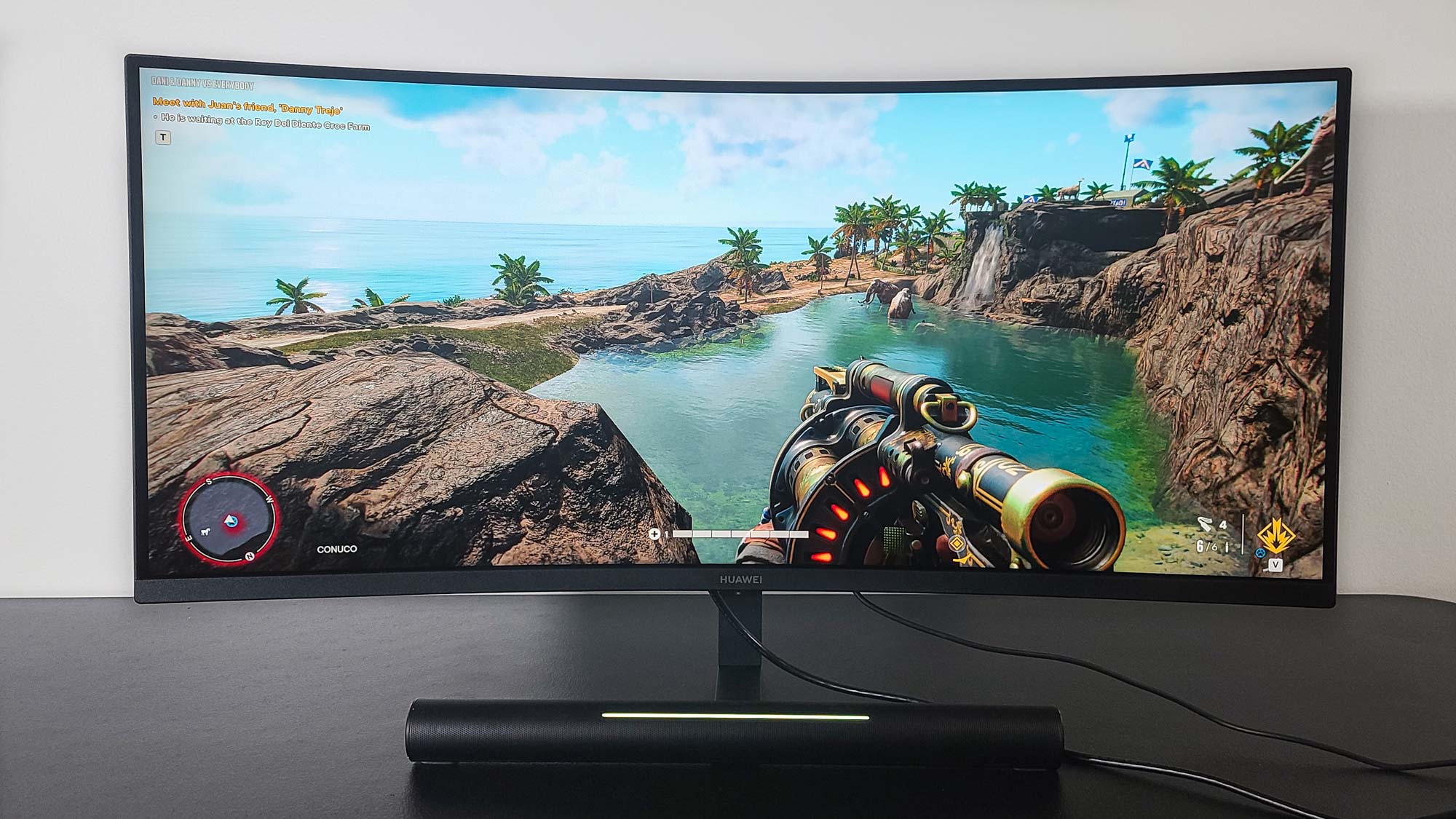
YouTube videos and movies played via streaming services were similarly fine, but remember that the wide, 21:9 attribute ratio means they will rarely (if ever) fill the MateView GT'due south screen.
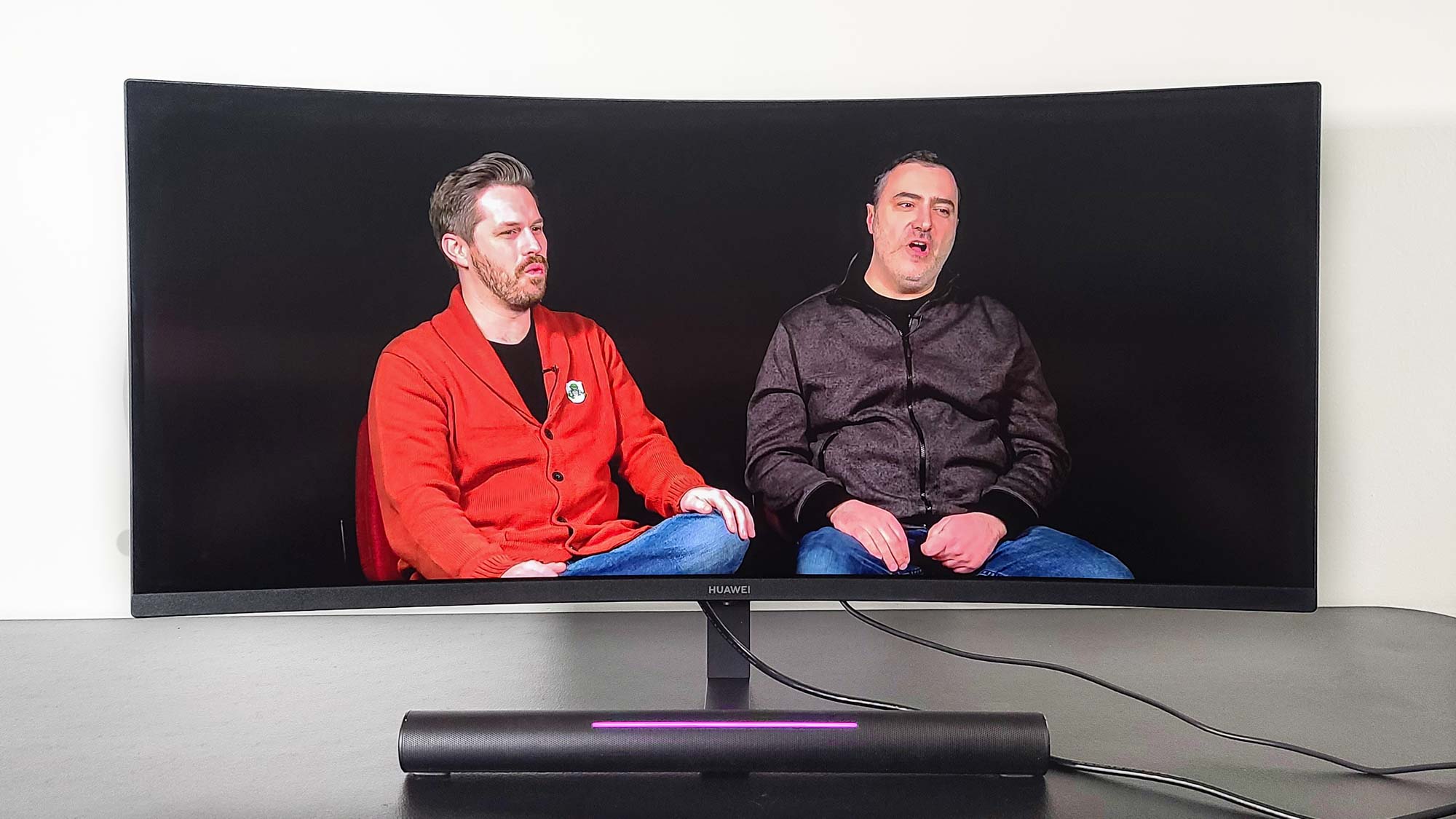
The effect of the aspect ratio will be determined a lot by what you're playing. If you're running an FPS where all the activeness and interface elements (if any) are in the center of the screen, you'll be fine. But longer monitors tend to be detrimental to the gaming experience if you lot frequently need to scan the farthermost sides or corners; it's not a problem on a traditional sixteen:9 display, of class, but when stretched out, those things will never be in your field of view. If it was hardly a challenge to the same degree as on the fifty-fifty wider Samsung Odyssey G9, it however came up on the MateView GT. It was nearly obvious with Civilisation 6 (where content on the sides is essential to gameplay) and was a lesser but however notable trouble with Assassin's Creed Valhalla.
On the other hand, Dirt v and Flight Simulator played superbly and at a college level of immersion than 16:9 can offer. In other words, permit your gaming preference guide you.
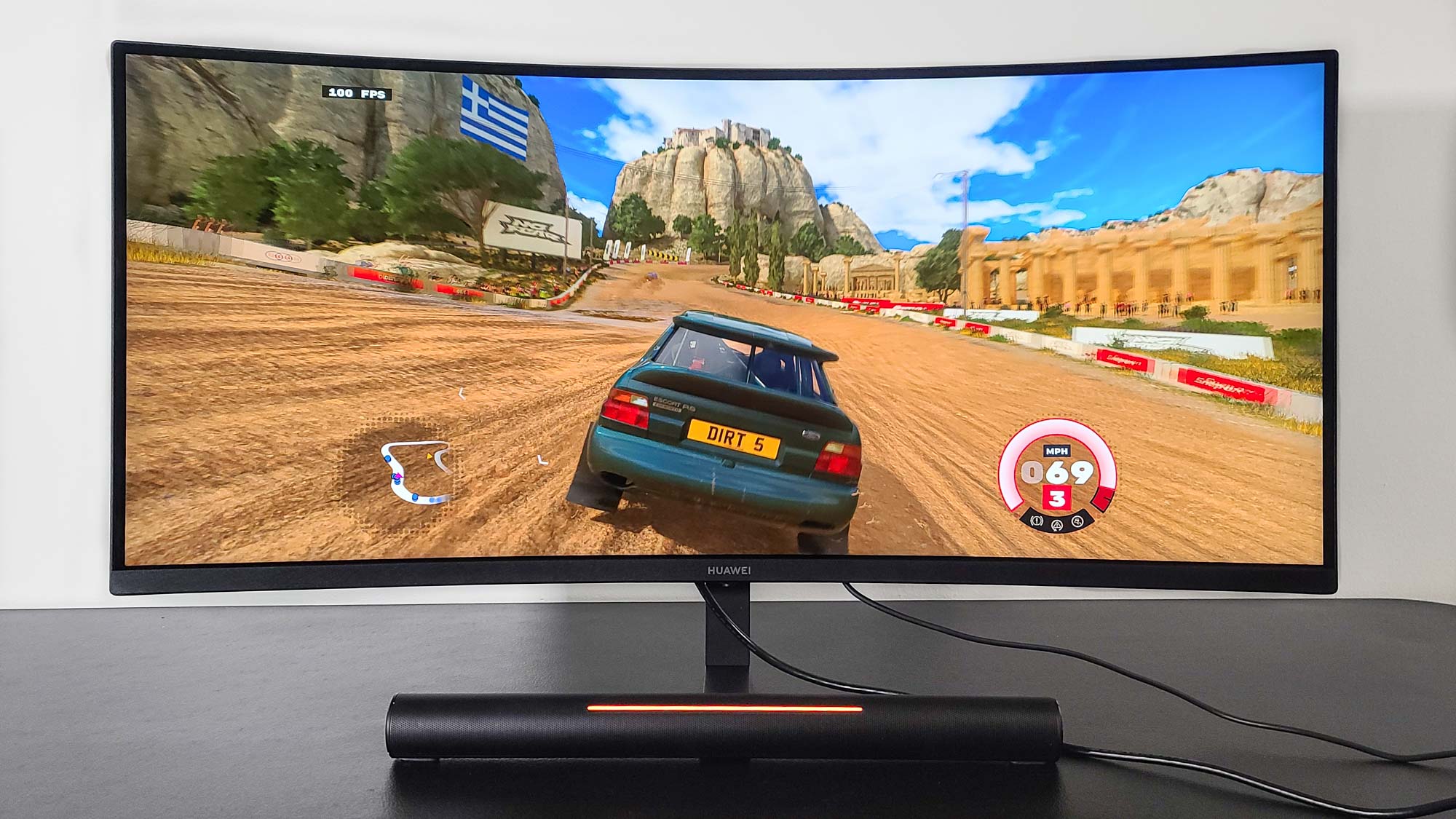
The soundbar is, unsurprisingly, a huge pace upwardly from typical integrated monitor speakers, offering a lot more volume and vibrant presence that can, if non bust the walls of a standard-size room, at to the lowest degree meet them head-on. That said, it's non stunning audio. There's not a great deal of bass — information technology was detectable in merely the flattest of ways listening to The Knife's "Silent Shout" — and some distortion crept into recordings of soprano vocals when the book was maxed out. Yous're withal best served past connecting a dedicated pair of good speakers to your PC or hooking the computer up to your living room's audio system, but this is a perfectly serviceable solution for gamers who don't fancy themselves off-hour audiophiles.
There's ane off attribute of the soundbar'southward design worth mentioning. By running your hand over the RGB strip, yous can raise or lower the monitor'south volume without having to become into the OSD (and the low-cal will change to reverberate the new level). This is a clever idea, but it's not much more convenient than doing information technology in Windows or having a hardware switch, due to the positioning of the strip on the soundbar'south forepart bend. And if you have the monitor at or near its lowest upwardly-downwardly position, you'll have to brush the strip while operating the joystick, which sends the volume jumping all over the range.
Huawei MateView GT review: Interface
With a blueish background, bold white lettering, and a satisfyingly low amount of default transparency, the MateView GT's OSD is easy to look at; the joystick also makes information technology piece of cake to navigate. There are 5 top-level menus, each of which offers a number of suboptions to choose from in customizing the monitor to your liking. In most cases, just selecting the menu will display the choices within it, which greatly simplifies the process of finding the setting you're looking for. The GamingVision carte du jour is where you adjust the motion-picture show mode (which may non be that intuitive), customize the lighting furnishings of the soundbar (including changing its color and flashing design), and tweak other game-axial features such as the dissimilarity-boosting Dark Field Control or a crosshairs overlay; Color is where you adjust the brightness, contrast, color temperature, and Depression Bluish Light function; in Picture, you tin set overdrive to any of five levels or modify the scaling; and Input Source and System Settings do exactly what you'd expect from their names.

One unique setting allows you to specify the "shortcut" for the joystick, or what happens when you lot button it in whatever management without clicking it first — a thoughtful addition I've never seen before. It's defective some of the inventive settings nosotros've seen on other monitors, such as the ability to save display or technical settings in customizable profiles you can pull up someday you want (the Aorus FI32U and the Gigabyte M32U both have these), and those would be nice additions. Merely overall, it's a fine interface that does near everything you'll need information technology to do.
Huawei MateView GT review: Verdict
Given all it offers, the Huawei MateView GT is a compelling cosmos from one of the world's leading manufacturers (if not one that always gets a lot of play or respect in the West), and aims to please everyone on one level or another. It comes shut to succeeding, with skillful operation in critical areas, and a lot of the kinds of bells and whistles gamers will appreciate.
It's the lack of fit and cease, though, that prevents the MateView GT from being a slam dunk — things similar the audio bar operation, the drab design, and the limited aligning options. Plus, you have to specifically desire an ultrawide without wanting to go as far every bit the more powerful (and more expensive) Samsung Odyssey G9 or as splashy every bit the LG 38GL950G, and in either case that means foregoing 4K. Because 4K monitors similar the Gigabyte Aorus FI32U or the Gigabyte M32U are more widely available for comparable prices and take as many or more features, and slightly lower-resolution xvi:nine monitors can cost hundreds less, you lot have to really want what Huawei is selling.
If you exercise, if yous live somewhere you lot can buy it, and especially if you don't have a sound setup worth talking about, the MateView GT is a expert way to tick most of the key boxes for less money than you lot may expect. But it may be more notable still as a sign of things to come up. If this is Huawei'south opening salvo in the monitor wars, nosotros're interested to meet what the company comes upward with next.
Source: https://www.tomsguide.com/reviews/huawei-mateview-gt
Posted by: harrisonfamannot61.blogspot.com


0 Response to "Huawei MateView GT review"
Post a Comment